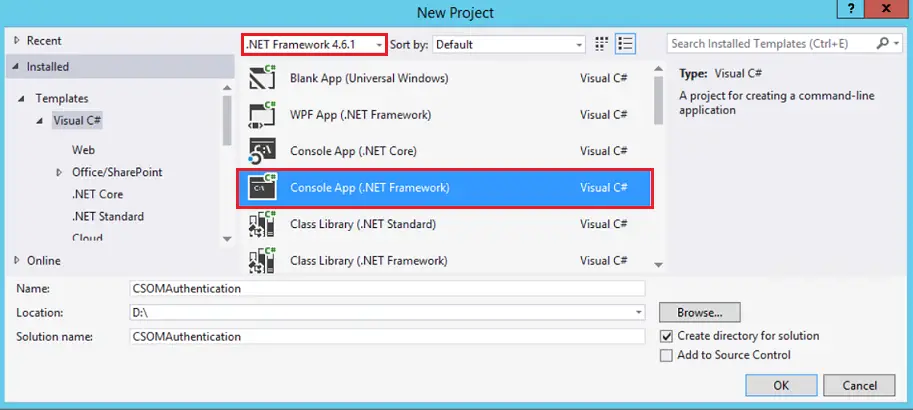The example in this topic show how to use CSOM to Set Regional Settings in SharePoint
- Please follow the steps below to execute the code in Visual Studio using
Console Application. You can customize the solution according to your requirements.
- Check the article to
Connect to SharePoint context using CSOM. This is very helpful
if you are doing any programming in CSOM.
- Don't forget to use the assemblies as mentioned in the code.
How to run CSOM code in SharePoint?
- Open your Visual Studio.
- From the template, select Console Application as shown in the screenshot
- Select the .Net Framework version from the top drop-down as well.
You can also change the .Net Framework after creating the solution.
- Enter Project Name, Location and Solution
Name and click on OK.

- Now your program.cs file will open. Copy the code in main function.
- Once you are done with your code, just hit F5 or Run the application.
- using Microsoft.SharePoint.Client;
- using System.Linq;
-
- using (ClientContext
clientContext = new ClientContext("http://MyServer/sites/MySiteCollection"))
- {
- Web
targetWeb = clientContext.Web;
- RegionalSettings regionalSettings = targetWeb.RegionalSettings;
- clientContext.Load(targetWeb, w => w.RegionalSettings,
w => w.RegionalSettings.TimeZones);
- clientContext.ExecuteQuery();
-
- // Note: The Locale ID controls the numbering,
sorting, calendar, and time formatting for the Web site
- // 1033 is for English (United States)
- targetWeb.RegionalSettings.LocaleId =
uint.Parse("1033");
-
- // Set Work Start Time
- targetWeb.RegionalSettings.WorkDayStartHour = 8;
-
- // Set Work End Time
- targetWeb.RegionalSettings.WorkDayEndHour = 5;
-
- // Work days: 127 = All, 0 = None, 64 = Sunday,
32 = Monday, 16 = Tuesday
- // 8 = Wednesday, 4 = Thursday, 2 = Friday,
1 = Sunday, 62 = Monday to Friday
- targetWeb.RegionalSettings.WorkDays = 62;
-
- // Specify whether you want to use 12-hour
time format or 24-hour format.
- targetWeb.RegionalSettings.Time24 =
true;
-
- // Specify a secondary calendar that provides
extra information on the calendar features
- // 1 = Gregorain(Localized), 2 = Gregorian
(always English strings), 3 = Japanese Era: Year of the Emperor
- // 4 =
Year of Taiwan, 5 = Tangun Era (Korea),6 = Hijri, 7 = Thai
- targetWeb.RegionalSettings.AlternateCalendarType = 1;
-
- // Specify the type of calendar
- // 0 — None, 1 — Gregorian, 3 — Japanese
Emperor Era, 5 — Korean Tangun Era
- // 6 — Hijri, 7 — Buddhist, 8 — Hebrew Lunar, 9 — Gregorian Middle East French Calendar
- // 10 — Gregorian Arabic Calendar, 11 — Gregorian
Transliterated English Calendar
- // 12 — Gregorian Transliterated French Calendar,
16 — Saka Era
- targetWeb.RegionalSettings.CalendarType = 1;
-
- // Set first day of week
- // 0 = Sunday and 6 = Saturday(last day)
- targetWeb.RegionalSettings.FirstDayOfWeek = 1;
-
- // Set first week of year
- // 0 = Starts on Jan 1, 1 = First full week,
2 = First 4-day week
- targetWeb.RegionalSettings.FirstWeekOfYear = 1;
-
- // Show week numbers in the Date Navigator
- targetWeb.RegionalSettings.ShowWeeks =
true;
-
- Microsoft.SharePoint.Client.TimeZone
utcTimeZone = targetWeb.RegionalSettings.TimeZones.Where(timezone => timezone.Description
== "(UTC-10:00) Hawaii").First();
-
- targetWeb.RegionalSettings.TimeZone = utcTimeZone;
-
- targetWeb.RegionalSettings.Update();
- clientContext.ExecuteQuery();
- }
Thank you for reading this article. This code was tested in SharePoint 2013